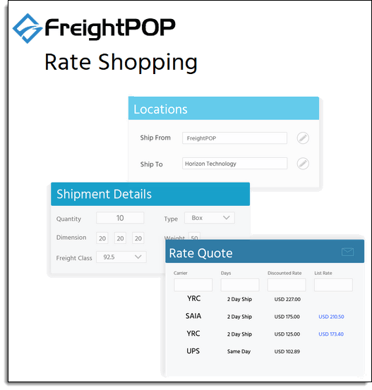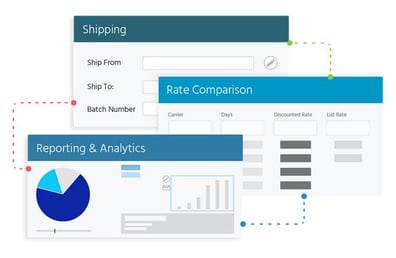Fast Shipping Process Tools Explored
FreightPOP’s time-saving shipping tools are huge, particularly for high-volume shippers and for those organizing multiple pallet shipments as one...

If you already use a Transportation Management System, you know it is invaluable on a day-to-day, per shipment basis. But the technology is swiftly moving forward. Evaluate yours today!
Undoubtedly automation was the first thing you looked for when selecting your Transportation Management System (TMS). But not all TMS automation tools are created equal.
The shipping automation tools you should have include:
Our TMS automates shipping management to the point that many of our customers can reallocate personnel up to 20-30%.
.jpg?width=457&name=Reallocate%20Resources%20to%20Grow_Option%202%20(2).jpg) One specific example of this was with a major online retailer that was able to move five staff from their shipping department into other areas of the business, as they were saving 200 man-hours a week due to the automation tools we provide. (To read more about this case see our post Grow Your Business With TMS.)
One specific example of this was with a major online retailer that was able to move five staff from their shipping department into other areas of the business, as they were saving 200 man-hours a week due to the automation tools we provide. (To read more about this case see our post Grow Your Business With TMS.)
Ideally, your automation tools should be continually evolving. At FreightPOP, we roll out new features every quarter to ensure our customers have the best tools to allow shippers to "ship smarter, and ship easier".
SLASH PROCESSING TIMES - Read 4Wall Entertainment Case Study
Robust connectivity will enable you to receive, update, and track orders from external applications inside the software. Much like how a smartphone is a centralized platform that allows users to interact with many data points seamlessly, a good TMS should offer that same user experience.
You need connection to multiple carriers, APIs, and to your own accounting, CRMs, and warehouse programs. All this data should come together in one TMS interface.
FreightPOP’s connectivity includes:
Solid connectivity saves you time and gives you more control. You should be able to easily manage scheduling shipments for all modes and batch shipping. Routing guides and end of day manifests should also be readily available through your TMS.
Bottom line: Rate shopping is a huge time-saving feature for shippers.
What would typically take a shipper up to half-an-hour in calling carriers or logging onto carrier websites to obtain quotes, can be scaled right down to an average of seconds per shipment.
 Our TMS enables the below type of rate shopping in a side-by-side layout for ease of selecting and printing out shipping labels.
Our TMS enables the below type of rate shopping in a side-by-side layout for ease of selecting and printing out shipping labels.
You can shop:
 A good transportation management system should enable shippers to isolate billing issues, audit carriers, and prove ROI to upper management. Analyzing your shipping data enables you to make informed decisions going forward. We offer freight reporting at the click of a button - or they can be automated to generate and email at specific times.
A good transportation management system should enable shippers to isolate billing issues, audit carriers, and prove ROI to upper management. Analyzing your shipping data enables you to make informed decisions going forward. We offer freight reporting at the click of a button - or they can be automated to generate and email at specific times.
Something to keep in mind about our solution is that we are highly customizable and are rolling out additional features and reporting capabilities all the time.
Your transportation management system should tell you if your shippers are shipping with the lowest cost available at the time of particular shipments, or if they might be shipping with a carrier at higher rates because they may be spiffing them gifts.
With our “Lowest Quote Shipping Compliance” report, for example, you can see how much of your shipment was sent out at the lowest cost rate vs. how much you could have saved if a higher rate was selected instead. You can also set date ranges on these reports to see when overspending was occurring, which will assist you in pinpointing the cause of the inefficiency.
The primary objective of your TMS is to help you save money and make shipping easier. This can be achieved through automation tools, connections to external data points, or even through reporting that shows you where you are leaving money on the table.
We created our TMS because we were shippers without the tools needed to save money on our shipping. We also found typical TMS solutions too cumbersome, not customizable enough to fit our business needs, and too expensive.
Check out our case study outlining how we helped full-service entertainment company 4Wall Entertainment improve their customer service and slash processing times!

FreightPOP’s time-saving shipping tools are huge, particularly for high-volume shippers and for those organizing multiple pallet shipments as one...

What's that? You need the best tools to save money on freight and shipping? Check out these seven tips to target the best TMS features that will do...

While shipping and logistics managers have numerous options and channels to choose from, some are still getting caught up in false promises...